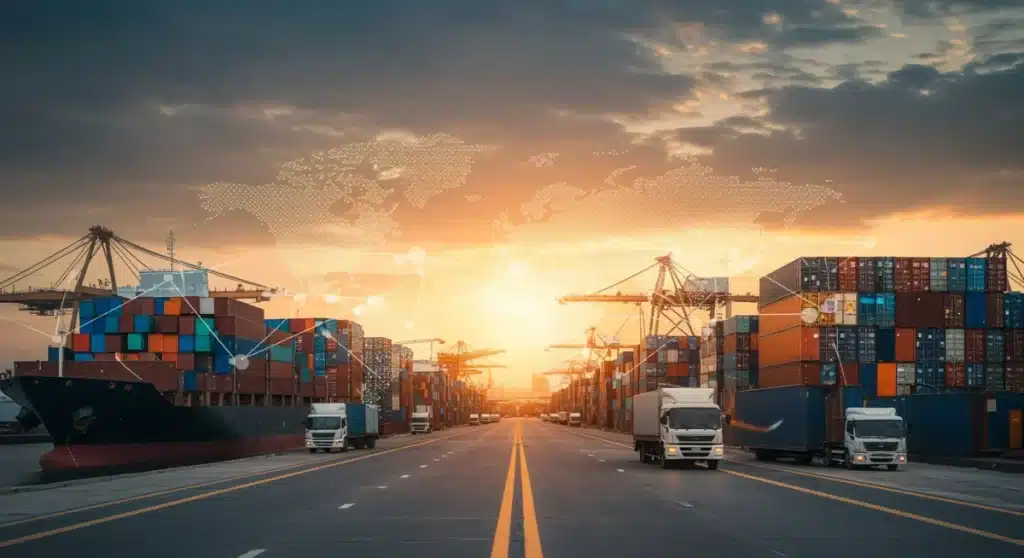Urgent Alert: 3 Major Supply Chain Disruptions Impacting U.S. Consumer Goods in Early 2025

Early 2025 is projected to bring significant challenges to U.S. consumer goods supply chains, primarily due to geopolitical tensions, climate-related events, and labor disputes, potentially leading to widespread product shortages and price increases across various sectors.
An Urgent Alert: 3 Major Supply Chain Disruptions Impacting U.S. Consumer Goods in Early 2025 is being sounded across industries, signaling potential turbulence for everything from daily necessities to high-tech gadgets. As we approach the new year, a confluence of global events and domestic issues threatens to reshape the availability and pricing of products on American shelves. Understanding these impending challenges is crucial for consumers and businesses alike to prepare for what lies ahead.
Geopolitical Tensions and Trade Route Blockages
The intricate web of global trade is highly susceptible to geopolitical shifts, and early 2025 is poised to witness significant impacts on U.S. consumer goods due to escalating international conflicts and critical trade route blockages. These events, often sudden and unpredictable, can throw meticulously planned logistics into disarray, leading to delays and increased costs.
Recent analyses suggest that persistent tensions in key maritime corridors, particularly in regions like the Red Sea and the South China Sea, will continue to pose substantial risks. These areas are vital arteries for global commerce, and any disruption there has a ripple effect that touches nearly every sector of the U.S. economy.
Impact on Shipping and Freight Costs
When primary shipping routes become unsafe or inaccessible, carriers are forced to reroute vessels, adding thousands of miles and weeks to transit times. This not only delays deliveries but also significantly inflates operational costs, which are inevitably passed on to consumers.
- Increased Transit Times: Longer routes mean goods spend more time at sea, delaying stock replenishment.
- Higher Fuel Consumption: Extended journeys require more fuel, directly impacting freight charges.
- Elevated Insurance Premiums: Navigating through high-risk areas or taking longer routes often increases insurance costs for cargo.
- Port Congestion: Rerouted ships can overwhelm alternative ports, leading to further delays in offloading and distribution.
Raw Material Access and Production Delays
Beyond finished goods, geopolitical instability also affects the supply of critical raw materials. Many U.S. industries rely on imports of components and raw resources from politically sensitive regions. Disruptions in these supply lines can halt production, creating shortages of essential consumer products.
For instance, the electronics industry, heavily dependent on rare earth minerals and specialized components often sourced from specific geopolitical hotspots, could face severe bottlenecks. Similarly, industries relying on specific chemical compounds or agricultural commodities might see their supply chains strained, leading to increased scarcity and higher prices for everything from appliances to packaged foods.
The continued uncertainty surrounding international relations and the security of major trade lanes will force businesses to re-evaluate their sourcing strategies and potentially absorb higher costs. Consumers, in turn, should anticipate longer waiting times for certain products and a general upward trend in prices as these geopolitical factors play out in early 2025.
Climate Change and Extreme Weather Events
The escalating frequency and intensity of climate-related events are no longer distant threats but immediate realities impacting global supply chains. Early 2025 is projected to bring significant disruptions to U.S. consumer goods due to extreme weather, affecting production, transportation, and agricultural output.
From severe droughts impacting agricultural yields to powerful storms damaging infrastructure, climate change introduces an unpredictable variable into an already complex system. These events can occur anywhere in the world, creating cascading failures across interconnected supply networks.
Agricultural Output and Food Supply
One of the most direct impacts of extreme weather is on agricultural production. Major food-producing regions globally are increasingly vulnerable to droughts, floods, and unseasonable temperatures. This directly threatens the availability and affordability of a wide range of food products for U.S. consumers.
- Crop Failures: Droughts and floods can devastate harvests, leading to shortages of staple crops like corn, wheat, and soybeans.
- Livestock Challenges: Extreme heat or cold can impact livestock health and feed availability, affecting meat and dairy production.
- Increased Food Prices: Reduced supply due to weather events inevitably drives up wholesale and retail food prices.
- Supply Volatility: Unpredictable weather makes future harvests uncertain, leading to market instability.
Infrastructure Damage and Logistics Bottlenecks
Beyond agricultural impacts, extreme weather events also pose a significant threat to transportation infrastructure. Ports, roads, railways, and airports can all be damaged or rendered inoperable by hurricanes, blizzards, and floods, severely impeding the movement of goods.
For example, a major hurricane striking a key U.S. port can shut down operations for days or weeks, causing massive backlogs of cargo. Similarly, severe winter storms can make road and rail transport impossible, preventing goods from reaching distribution centers and retail outlets. This infrastructure damage not only delays current shipments but also requires extensive repairs, leading to long-term logistical challenges and increased costs for businesses.
As climate patterns become more erratic, businesses are increasingly investing in resilient supply chain strategies, but the sheer scale of potential disruptions means consumers should prepare for intermittent shortages and higher prices on a variety of goods influenced by global and domestic weather patterns in early 2025.
Labor Disputes and Workforce Shortages
The stability of supply chains hinges significantly on a robust and available workforce, yet early 2025 is expected to see U.S. consumer goods impacted by ongoing labor disputes and persistent workforce shortages across critical sectors. These issues, ranging from contract negotiations to demographic shifts, can severely impede the flow of goods from production to the consumer.
Labor actions, such as strikes or slowdowns, at pivotal points in the supply chain—like ports, trucking companies, or manufacturing facilities—can create immediate and widespread bottlenecks. Coupled with long-term trends of labor scarcity in specialized roles, the potential for disruption becomes substantial.

Impact of Strikes and Contract Negotiations
Major labor unions in sectors vital to the supply chain, including longshoremen, railway workers, and truck drivers, regularly engage in contract negotiations. When these negotiations break down, strikes can ensue, bringing critical logistical operations to a standstill. Even the threat of a strike can cause companies to divert shipments, leading to inefficiencies and delays.
For example, a strike at a major West Coast port could cripple the import of Asian-manufactured goods, affecting everything from electronics to apparel. Similarly, disruptions in the trucking industry due to labor disputes can prevent goods from reaching inland distribution centers, leaving retail shelves empty.
Worker Shortages in Key Sectors
Beyond active disputes, the U.S. faces a chronic shortage of skilled labor in several essential supply chain roles. The trucking industry, for instance, has long grappled with a deficit of qualified drivers, a problem exacerbated by an aging workforce and difficulties in attracting new talent. This shortage directly limits the capacity to transport goods efficiently across the country.
Similarly, warehouses and distribution centers often struggle to find enough workers, especially during peak seasons. This can lead to delays in processing and fulfilling orders, impacting delivery times for online purchases and stock levels in physical stores. The specialized nature of some logistics roles also means that these shortages cannot be easily or quickly resolved, posing a persistent challenge for early 2025.
- Truck Driver Shortages: Limits capacity for overland transport, increasing delivery times and costs.
- Port Worker Availability: Affects loading and unloading efficiency, contributing to port congestion.
- Warehouse Staffing: Delays in sorting, packing, and dispatching goods from distribution centers.
- Manufacturing Labor Gaps: Reduces production output, leading to shortages of finished products.
These labor-related challenges are multifaceted, stemming from a combination of economic factors, working conditions, and demographic trends. Businesses are exploring automation and other solutions, but the immediate impact on U.S. consumer goods in early 2025 will likely be felt through slower deliveries, reduced product availability, and potentially higher prices as companies contend with increased labor costs and inefficiencies.
The Ripple Effect on Consumer Goods and Prices
The three major supply chain disruptions—geopolitical tensions, climate change, and labor issues—do not operate in isolation; rather, they interact in complex ways, creating a significant ripple effect across the U.S. consumer goods market. This interconnectedness means that a disruption in one area can quickly cascade, magnifying its impact on product availability and pricing.
Consumers should brace for a period of heightened volatility, where the cost and accessibility of everyday items become more unpredictable. Understanding this interconnectedness helps in appreciating the systemic nature of the challenges facing the economy.
Increased Inflationary Pressures
Each disruption contributes to rising costs within the supply chain. Rerouting ships due to geopolitical conflicts, repairing infrastructure after extreme weather, or negotiating higher wages during labor disputes all add to the operational expenses for businesses. These increased costs are almost invariably passed on to the consumer, fueling inflationary pressures.
When multiple disruptions occur simultaneously, the effect is compounded. For example, if a port strike delays shipments of electronics, and simultaneously, a drought impacts the cost of agricultural products, consumers will see price hikes across a broad spectrum of goods. This broad-based inflation can erode purchasing power and make budgeting more challenging for households.
Product Scarcity and Availability Challenges
Beyond price, the most tangible impact for consumers will be product scarcity. Delays in shipping, halts in production, or difficulties in distribution mean that goods simply won’t be available on shelves when expected. This can lead to frustration, panic buying, and a general reduction in consumer choice.
- Longer Lead Times: Consumers might have to wait significantly longer for back-ordered items, especially for durable goods like appliances or furniture.
- Limited Stock: Retailers may carry less inventory, leading to frequent out-of-stock situations for popular products.
- Reduced Variety: Supply chain issues can force retailers to streamline their offerings, meaning fewer brand choices for consumers.
- Regional Disparities: Some regions might experience more severe shortages than others, depending on their proximity to affected supply hubs.
The combined effect of these disruptions suggests that early 2025 will be a period where consumers need to be more adaptable and proactive in their shopping habits. Planning purchases, being flexible with brand choices, and anticipating potential delays will become more commonplace as the ripple effect of these supply chain challenges is felt nationwide.
Strategies for Businesses to Mitigate Disruptions
In the face of these formidable supply chain challenges, businesses are not without recourse. Proactive strategies and adaptive measures can significantly mitigate the impact of geopolitical tensions, climate events, and labor disputes on their operations and, by extension, on U.S. consumer goods availability. The focus is shifting from efficiency at all costs to building resilience and flexibility.
Companies that invest in robust risk management and diversified sourcing will be better positioned to navigate the turbulent waters of early 2025 and beyond. This requires a multi-faceted approach that addresses various points of potential failure within the supply chain.
Diversifying Sourcing and Manufacturing
One of the most critical strategies is to reduce reliance on single points of origin for raw materials, components, or finished goods. “China Plus One” strategies, where companies look beyond China for additional manufacturing bases, are becoming more prevalent. Similarly, diversifying suppliers within different regions can cushion the blow if one area is hit by a natural disaster or political instability.
Nearshoring or reshoring production—bringing manufacturing closer to the U.S. or back to the U.S. entirely—is another powerful tactic. While potentially increasing initial costs, it reduces transit times, minimizes exposure to international shipping risks, and can offer greater control over labor conditions.
Investing in Technology and Data Analytics
Technology plays a pivotal role in enhancing supply chain visibility and responsiveness. Advanced data analytics, AI-driven forecasting, and real-time tracking systems can help businesses anticipate disruptions, identify bottlenecks, and react swiftly.
- Predictive Analytics: Using historical data and AI to forecast potential disruptions from weather patterns or geopolitical shifts.
- Real-time Tracking: Implementing IoT devices and GPS tracking to monitor goods’ movement and identify delays instantly.
- Blockchain for Transparency: Enhancing traceability of products from source to consumer, improving accountability and trust.
- Automated Warehousing: Reducing reliance on manual labor in distribution centers to mitigate impacts from labor shortages.
Building Inventory Buffers and Strategic Partnerships
While just-in-time inventory models prioritize efficiency, the current climate necessitates a re-evaluation. Holding strategic inventory buffers for critical components or finished goods can provide a cushion during unexpected disruptions. This doesn’t mean reverting to massive stockpiles, but rather intelligently managing safety stock levels.
Furthermore, forging stronger, more collaborative relationships with suppliers, logistics providers, and even competitors can create a more resilient ecosystem. Sharing information, coordinating efforts, and establishing contingency plans collectively can enhance the entire supply chain’s ability to withstand shocks. These strategies are essential for businesses aiming to maintain stability and continue serving U.S. consumer goods markets effectively in early 2025.
Consumer Preparedness and Adaptability
As businesses adapt to the anticipated supply chain disruptions, consumers also have a role to play in navigating the challenges of early 2025. Preparedness and adaptability will be key to minimizing personal impact from potential product shortages and price fluctuations across U.S. consumer goods. A proactive approach can help manage expectations and secure essential items.
Understanding that the global market is interconnected and susceptible to various pressures allows for more informed decision-making regarding purchasing habits and household planning.
Smart Shopping and Early Planning
One of the most effective strategies for consumers is to engage in smart shopping practices. This includes monitoring news related to supply chain forecasts, especially for products critical to their households. For non-perishable goods, purchasing slightly ahead of need, when prices are stable or sales are available, can be beneficial.
For larger purchases, such as appliances or electronics, anticipating longer lead times and ordering well in advance will be crucial. Avoiding last-minute shopping for essential items can prevent frustration and potential overpaying during periods of scarcity.
Embracing Flexibility and Alternatives
The ability to be flexible with brands and product specifications will also serve consumers well. If a preferred brand of a certain item is unavailable or significantly more expensive due to supply chain issues, being open to trying alternative brands or different product types can prevent shortages in the household.
- Brand Flexibility: Be willing to switch brands if your usual choice is out of stock or too expensive.
- Product Substitutions: Consider alternative products that serve a similar purpose if specific items are unavailable.
- Local Sourcing: Prioritize local farmers’ markets and small businesses for fresh produce and artisan goods, reducing reliance on global supply chains.
- DIY Solutions: For some non-essential items, consider DIY alternatives if store-bought versions are scarce.
Financial Planning and Budgeting
Given the likelihood of increased prices, careful financial planning and budgeting become even more important. Allocating a slightly larger portion of the household budget for groceries and essential goods can help absorb potential price hikes without undue strain. Building a small emergency fund specifically for unexpected cost increases can also provide a buffer.
Moreover, being mindful of discretionary spending and prioritizing needs over wants will be a prudent approach. While these disruptions present challenges, informed consumers can mitigate many of the adverse effects by adopting a strategic and adaptable mindset in early 2025.
| Key Disruption | Brief Impact on U.S. Consumers |
|---|---|
| Geopolitical Tensions | Increased shipping costs and delays for imported goods, affecting electronics and apparel. |
| Climate Events | Agricultural output reductions and infrastructure damage, leading to food shortages and higher prices. |
| Labor Disputes/Shortages | Delays in transportation and distribution, impacting product availability and delivery times. |
| Overall Impact | Higher prices, reduced product availability, and increased market volatility for U.S. consumer goods. |
Frequently Asked Questions About Supply Chain Disruptions
The primary causes are a combination of escalating geopolitical tensions impacting critical trade routes, increased frequency and intensity of climate-related extreme weather events, and ongoing labor disputes coupled with persistent workforce shortages in key logistics sectors. These factors collectively create significant vulnerabilities.
U.S. consumer goods will likely face higher prices due to increased operational costs for businesses, reduced product availability from manufacturing and shipping delays, and potential shortages of specific items, ranging from electronics to everyday food staples, impacting household budgets and choices.
Businesses can mitigate impacts by diversifying sourcing and manufacturing locations, investing in advanced supply chain technology and data analytics for better visibility, and building strategic inventory buffers. Forming stronger partnerships with suppliers and logistics providers also enhances resilience.
Consumers can prepare by adopting smart shopping habits, planning purchases in advance, and being flexible with brands and product choices. Embracing local sourcing, maintaining a household budget, and having an emergency fund for unexpected cost increases are also prudent strategies.
While some immediate impacts may be temporary, the underlying causes—geopolitical shifts, climate change, and demographic labor trends—suggest that supply chain volatility is likely to be a persistent feature. Businesses and consumers should plan for ongoing adaptability rather than a quick return to pre-disruption norms.
Conclusion
The convergence of geopolitical tensions, intensifying climate change impacts, and persistent labor challenges sets the stage for a turbulent period for U.S. consumer goods in early 2025. These three major supply chain disruptions underscore the fragility of global interconnectedness and the need for both businesses and consumers to adopt proactive and adaptive strategies. While the outlook suggests potential for increased prices, reduced availability, and market volatility, informed preparation can significantly cushion the impact. By understanding the underlying drivers and implementing resilient measures, stakeholders can navigate these challenges more effectively, ensuring a steadier flow of essential goods and a more stable economic landscape for the future.






